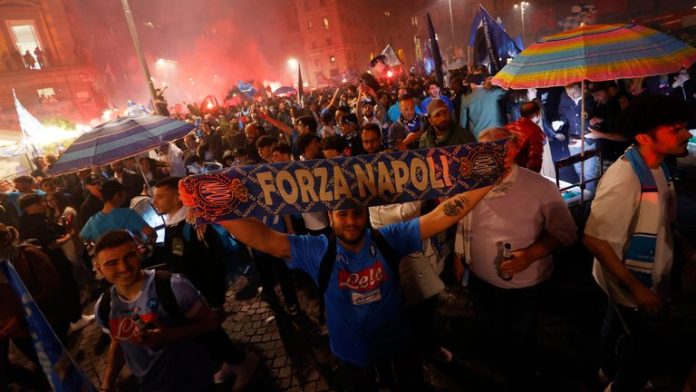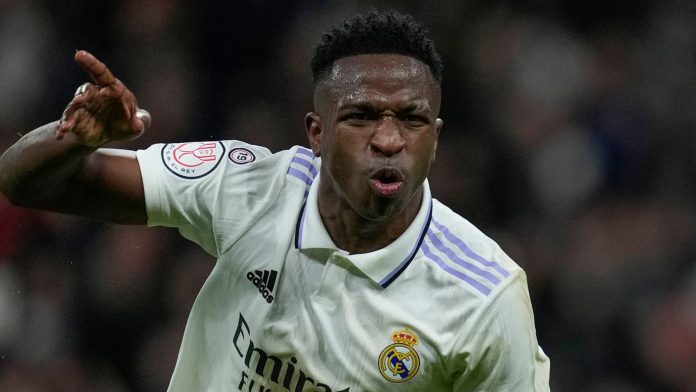With one SV Darmstadt ultra taking to the field to give the players a dressing down following their recent Bundesliga defeat, we’ve taken a look at football’s biggest ultras groups.
Football is a game that stirs up passion like no other. Organised fan groups and supporter bases have been around for a very long time, with many adopting identities and slogans of their own.
Many of these die-hard ‘ultras’ groups are world-famous in their own right, for good and bad reasons. But one such ultra from Bundesliga side Darmstadt went so far as to enter the pitch at full time after his side’s 6-0 home loss to Augsburg.
With his team at rock bottom of the German top flight, fans have had enough, but it’s the ultras who have been passionate enough to tell the players to their faces.
🚨🇩🇪 Madness in Bundesliga! After Darmstadt's 6-0 loss to Augsburg at home, an ultra went on the pitch and started screaming at the squad. 🤬
Darmstadt are currently rock bottom of the Bundesliga, they will play Leipzig & Bayern next .
— EuroFoot (@eurofootcom) March 3, 2024
While this fan’s outburst shows without a doubt that Augsburg’s ultras are passionate, they still have a way to go to match up to some of football’s biggest ultras groups.
Here’s a list of some of the biggest and most famous ultras sections in the football world.
Football’s Biggest Ultras Groups
Hajduk Split – Torcida Split
First up are the very first ultras group in Europe. Torcida Split formed when a group of students in Zagreb saw the passion of Brazilian fans at the 1950 World Cup.
Becoming the oldest organised supporters group in Europe, the ultras wing of Hadjuk Split has formed close ties with other fan bases. They have relationships with the ultras groups of clubs like Benfica and St Etienne, as well as Tornado Zadar and Polich outfit Gornik Zabrze.
02/03/2024 Croatia🇭🇷 Fury Torcida Split 🤯 Hajduk Split at home vs Istra. pic.twitter.com/oMo0ckgVPK
— 𝐂𝐚𝐬𝐮𝐚𝐥 𝐔𝐥𝐭𝐫𝐚 𝐎𝐟𝐟𝐢𝐜𝐢𝐚𝐥 (@thecasualultra) March 2, 2024
With branches throughout the world, the group has a presence almost everywhere there is a decent sized Croatian population.
Dinamo Zagreb – Bad Blue Boys
Next are another Croatian side, Dinamo Zagreb. Their Ultras – known as the “Bad Blue Boys” (BBB) formed in 1986 in Zagreb. They took their ‘bad boys’ name from the 1983 Sean Penn film of the same name.
Initially, they had great support from the first Croatian president, Franjo Tudman. With the country declaring independence from Yugoslavia in the 1990s, Tudman and the BBB shared close ties.
But that relationship collapsed after the president tried to change Dinamo Zagreb’s name to NK Croatia. The ultras group have solid links to Panathinaikos’ Gate 13 ultras, as well as Dinamo Kyiv, Dinamo Tbilisi and AS Roma.
Dinamo Zagreb vs Rijeka 25/02/24🇭🇷 #ultras #badblueboys #bbb pic.twitter.com/UvucKgXSv1
— SUPER TIFOS WORLD (@SUPER_TIFOS) February 26, 2024
In 2023, 104 fans were arrested after a mass brawl in which a 29-year old fan was killed. The fight happened as a result of 120 BBB members travelling to AEK Athens for a Champions League playoff fixture having been told to stay away. Eight fans were injured in total, according to the Greek authorities.
Ferencvaros – Green Monsters
Sticking in South Eastern Europe, Hungarian side Ferencvaros is next on the list of football’s biggest ultras. Known as the “Green Monsters”, their ultras were formed in 1995.
Their fanatical support is particularly evident during the Budapest derby against rivals Újpest.
A Budapest Derby with a difference: Ultras from both Ferencváros and Újpest returned for the first time in four years and they didn't disappoint 📈 pic.twitter.com/RKuajb16WQ
— COPA90 (@Copa90) April 3, 2018
B-közép, as they are known in Hungarian, boycotted games in 2015 after the Hungarian FA began taking palm prints of supporters. The move to curb ultras attending games was eventually overturned.
For a smaller club, Ferencvaros’ Green Monsters are known for being some of the most passionate ultras in Europe, as well as the most violent.
River Plate – Los Borrachos Del Tablón
Not many places do football like South America. Argentinian side Rive Plate have some of the fiercest supporters in the world.
Their supporters group are known as Los Borrachos del Tablón. Referred to more commonly as a ‘barra brava’ than an ultras group, they are known for provoking violence from other sets of fans.
River Plate Argentina.
Football ultras are built different.
Madness.
Imagine being one of them. pic.twitter.com/XN5tfY1ST8
— Un-bhadralok bangali (@goonereol) June 9, 2023
The rivalry between River Plate and Boca Juniors is one of the biggest in the world. Games between the two usually end in bloodshed, with the 2002 shooting of a Boca Juniors fan causing the suspension of the ‘superclasico’ for a time.
St Pauli
This next ultras group are different from the rest. Fans of German Bundesliga 2 club St Pauli are fiercely left-wing in their ideology.
Positioning themselves as anti-racist, anti-racist, anti-homophobic and anti-sexist, they frequently clash with far right-wing opponents and neo-nazi groups.
FC ST. PAULI WOMEN hosted city rivals Hamburger SV in German Cup. Club ultras called for fans to show up. Response was huge ☠️🔥
🇩🇪🤘 Germans also get that a little metal makes everything better. Esp. walkout songs 😈🔔🔊 SOUND UP [Via @ftamsut]pic.twitter.com/8mdNJaCZVK
— Men in Blazers (@MenInBlazers) September 9, 2023
Unusually inclusive for an ultras section, they have earned widespread attention. The Hamburg-based club have good links to Celtic, AEK Athens, Partizan Minsk and Ternana among others.
They even have an Indian supporters group known as the ‘Raj Pauli’.
S.S. Lazio – Irriducibili
On the opposite end of the political spectrum, Lazio’s ultras are infamous the world over. The Irriducibili do not shy away from their neo-nazi connections, with banners and slogans linking them to far-right causes frequently seen at games.
Performance Curva Nord Lazio & Curva Maestrelli at match against Milan
(01.03.2024) 🇮🇹🔵⚪⚫#SerieA #LazioMilan #sslazio #curvanordlazio #irriducibili #pyro #ultras #footballfans pic.twitter.com/87t8FpMib1— Ultras World (@Ultrasworld_uw) March 2, 2024
The rivalry with AS Roma is monumental. The Derby Della Capitale always throws up fireworks, with Lazio’s fans subjecting opposition and even their own players to racial abuse and hatred.
Such behaviour has earned the Irriducibili fame, as well as hatred from many parts of the footballing landscape.
Red Star Belgrade – Delije
Serbian outfit Red Star Belgrade’s ultras call themselves “Delije”. Roughly translated as ‘heroes’ or ‘braves’, the group has ties as far back as the 1940s.
Formally named and founded in 1989, they are strongly nationalist in their identity. Their Orthodox faith has granted them close ties to the likes of Olympiacos and Spartak Moscow.
Red Star Belgrade #ultras pic.twitter.com/jfq59SWmE5
— ULTRASEUROPE (@EuropeULTRAS) February 22, 2013
A famous and dark day for the club came in 1990, when they met with Dinamo Zagreb. The Delije and Bad Boys Blue collided violently before and after the match, with tensions in Yugoslavia already at boiling point.
While of course the football violence was not the cause of the Yugoslav war, the match is often remembered as one of the first flashpoints in the build-up to the wider conflict.
Galatasaray S.K – ultrAslan
Seen by many as football’s biggest ultras group by numbers, Galatasaray’s ultrAslan have a reported 100,000 members. The group was founded in 2001 by supporter Alparslan Dikmen when the club began to establish itself in European competitions.
The Galatasaray-fans are READY for the derby! 🏟🦁🔥pic.twitter.com/7STHARZf9g
— Football in Türkiye ⚽️🇹🇷 (@KaralarOsman1) March 3, 2024
Known for their creative and spectacular displays, the group brought 3,000 flares to a game against Fenerbahçe in 2001. The pyrotechnics interrupted the match, causing the Turkish FA to ban them from all games from then onwards – not that it deterred most.
Rarely for an ultras group, ultrAslan are not politically affiliated. But they are still extremely passionate and have been known for violent and dangerous behaviour at times.
S.S.C. Napoli
One of the top clubs in Italy, Serie A side Napoli have a huge following. With several different ultras sections, the most famous are Commando Ultras Curva B, ultras Napoli and Fedayn.
All three are fervent and proud supporters of Napoli, and share a strong Neapolitan identity that’s very distinct from the north of the country.
28.02.2024🇮🇹 ~10 000 ultras Napoli away in Sassuolo https://t.co/Fjy3xrlEmQ pic.twitter.com/Lr81NUN03M
— Hooligans.cz Official (@hooliganscz1999) February 29, 2024
Napoli were one of the first club in Italy to gain an ultras section, using pyrotechnics and flares as part of their displays. But in recent years, their reputation has been damaged by violence towards visiting fans.
Olympique de Marseille – Commando Ultra 84
Ligue 1 side Marseille’s Commando Ultra 84 are last on our list of football’s biggest ultras. Known for perhaps the most passionate support in the world, they are the oldest ultras in France.
They formed in 1984, and have a reputation for using banners and tifo’s to display their support. As a result of their passion, the Orange Velodrome is known for one of the best atmosphere’s of any ground in the world.
Pendant le jump hier, j'ai un jeune à côté de moi.
-Elle est où ton écharpe ?
-🤷♂️
J'ai rien contre la mode casual full black en Lyle & Scott, mais l'écharpe au stade, c'est la base, une seconde peau.
Et les tifos seront plus beaux.#NoScarfNoParty#NosCouleursSontBleuEtBlanc pic.twitter.com/GGTNRzfUzf— Le roi du jaune (@du_jaune) February 26, 2024
Marseille’s rivalry with PSG is well-documented. In particular, their ultras – the Bologne Boys – often clash with their Marseille counterparts.
The fierce rivalry is exacerbated by CU84’s left-wing ideology versus the right-wing support of PSG’s ultras.
Football is more than just a hobby to the people of Marseille, and their ultras section reflects this. If you ever visit any of these stadiums, you will quickly realise just how much the teams matter to their supporters.
And nowhere is that shown more clearly than by the desperate anger displayed by that SV Darmstadt fan at the beginning of the article.
Add Sportslens to your Google News Feed!






